Long-Term Suspended Sediment Concentrations and Loads from a Relatively Undisturbed Agroforested Catchment in the Northwest of the Iberian Peninsula
Abstract
:1. Introduction
2. Materials and Methods
2.1. The Study Area
2.2. Data Acquisition and Analysis
3. Results and Discussion
3.1. General Characterization of the Hydrological Context of the Study Period
3.2. Dynamics in Suspended Sediment Concentrations
3.3. Dynamics in Suspended Sediment Load at Different Time Scales
3.4. Implications of the Results
4. Conclusions
Author Contributions
Funding
Acknowledgments
Conflicts of Interest
References
- Collins, A.L.; Zhang, Y.S.; Duethmann, D.D.; Walling, D.E.; Black, K.S. Using a novel tracing-tracking framework to source fine-grained sediment loss to watercourses at sub-catchment scale. Hydrol. Process. 2012, 27, 959–974. [Google Scholar] [CrossRef]
- Panagos, P.; Imeson, A.; Meusburger, K.; Borrelli, P.; Poesen, J.; Alewell, C. Soil conservation in Europe: Wish or reality? Land Degrad. Dev. 2016, 27, 1547–1551. [Google Scholar] [CrossRef]
- Owens, P.N.; Batalla, R.J.; Collins, A.J.; Gomez, B.; Hicks, D.M.; Horowitz, A.J.; Kondolf, G.M.; Marden, M.; Page, M.J.; Peacock, D.H.; et al. Fine-grained sediment in river systems: Environmental significance and management issues. River Res. Appl. 2005, 21, 693–717. [Google Scholar] [CrossRef]
- Horowitz, A.J. Determining annual suspended sediment and sediment-associated trace element and nutrient fluxes. Sci. Total Environ. 2008, 400, 315–343. [Google Scholar] [CrossRef] [PubMed]
- Grove, M.K.; Bilotta, G.S.; Woockman, R.R.; Schwartz, J.S. Suspended sediment regimes in contrasting reference-condition freshwater ecosystems: Implications for water quality guidelines and management. Sci. Total Environ. 2015, 502, 481–492. [Google Scholar] [CrossRef] [PubMed]
- Buendia, C.; Herrero, A.; Sabater, S.; Batalla, R.J. An appraisal of the sediment yield in western Mediterranean river basins. Sci. Total Environ. 2016, 572, 538–553. [Google Scholar] [CrossRef] [PubMed]
- de Vente, J.; Poesen, J. Predicting soil erosion and sediment yield at the basin scale: scale issues and semi-quantitative models. Earth Sci. Rev. 2005, 71, 95–125. [Google Scholar] [CrossRef]
- Rodríguez-Blanco, M.L.; Taboada-Castro, M.M.; Taboada-Castro, M.T. Linking the field to the stream: Soil erosion and sediment yield in a rural catchment, NW Spain. Catena 2013, 102, 74–81. [Google Scholar] [CrossRef]
- Rodrigues, V.; Estrany, J.; Ranzini, M.; de Cicco, V.; Tarjuelo Martín-Benito, J.M.; Hedo, J.; Lucas-Borja, M.E. Effects of land use and seasonality on stream water quality in a small tropical catchment: The headwater of Córrego Água Limpa, São Paulo (Brazil). Sci. Total Environ. 2018, 622, 1553–1561. [Google Scholar] [CrossRef] [PubMed]
- Bilotta, G.S.; Krueger, T.; Brazier, R.E.; Butler, P.; Freer, J.; Hawkins, J.M.B.; Haygarth, P.M.; Macleod, C.J.A.; Quinton, J.N. Assessing catchment-scale erosion and yields of suspended solids from improved temperate grassland. J. Environ. Monit. 2010, 12, 731–739. [Google Scholar] [CrossRef] [PubMed] [Green Version]
- López-Tarazón, J.A.; Estrany, J. Exploring suspended sediment delivery dynamics of two Mediterranean nested catchments. Hydrol. Process. 2017, 31, 698–715. [Google Scholar] [CrossRef]
- Rodríguez-Blanco, M.L.; Taboada-Castro, M.M.; Taboada-Castro, M.T. Factors controlling hydro-sedimentary response during runoff events in a rural catchment in the humid Spanish zone. Catena 2010, 82, 206–217. [Google Scholar] [CrossRef]
- Sherriff, S.C.; Rowan, J.S.; Melland, A.R.; Jordan, P.; Fenton, O.; Ó’hUallacháin, D. Identifying the controls of soil loss in agricultural catchments using ex situ turbidity-based suspended sediment monitoring. Hydrol. Earth Syst. Sci. Discuss. 2015, 12, 2707–2740. [Google Scholar] [CrossRef]
- Clark, K.E.; Shanley, J.B.; Scholl, A.M.; Perdrial, N.; Perdrial, J.N.; Plante, A.F.; McDowell, W.H. Tropical river suspended sediment and solute dyanmics in storm during an extreme drought. Water Resour. Res. 2017, 53, 3695–3712. [Google Scholar] [CrossRef]
- Nadal-Romero, E.; Peña-Angulo, D.; Regüés, D. Rainfall, runoff, and sediment transport dynamics in a humid mountain badland area: Long-term results from a small catchment. Hydrol. Process. 2018. [Google Scholar] [CrossRef]
- Moran, M.S.; Peters, D.P.C.; McClaran, M.P.; Nichols, M.H.; Adams, M.A. Long-term data collection at USDA experimental sites for studies of ecohydrology. Ecohydrology 2008, 1, 377–393. [Google Scholar] [CrossRef]
- García-Ruiz, J.M.; Beguería, S.; Nadal-Romero, E.; González-Hidalgo, J.C.; Lana-Renault, N.; Sanjuán, Y. A meta-analysis of soil erosion rates across the world. Geomorphology 2015, 239, 160–173. [Google Scholar] [CrossRef] [Green Version]
- Duvert, C.; Nord, G.; Gratiot, N.; Navratil, O.; Nadal-Romero, E.; Mathys, N.; Némery, J.; Regüés, D.; García-Ruíz, J.M.; Gallart, F.; et al. Towards prediction of suspended sediment yield from peak discharge in small erodible mountainous catchments (0.45–22 km2) of France, Mexico and Spain. J. Hydrol. 2012, 454, 42–55. [Google Scholar] [CrossRef]
- Nunes, J.P.; Bernard-Jannin, L.; Rodríguez-Blanco, M.L.; Santos, J.; de Oliveira Alves, C.; Keizer, J.J. Hydrological and erosion processes in terraced fields: Observations from a humid Mediterranean region in northern Portugal. Land Degrad. Dev. 2016. [Google Scholar] [CrossRef]
- Palleiro, L.; Rodríguez-Blanco, M.L.; Taboada-Castro, M.M.; Taboada-Castro, M.T. Hydroclimatic control of sediment and metal export from a rural catchment in northwestern Spain. Hydrol. Earth Syst. Sci. 2014, 18, 3663–3673. [Google Scholar] [CrossRef] [Green Version]
- Zabaleta, A.; Antigüedad, I.; Barrio, I.; Probst, J. Suspended sediment delivery from small catchments to the Bay of Biscay. What are the controlling factors? Earth Surf. Process. Landf. 2016, 43, 1894–1910. [Google Scholar] [CrossRef]
- IPCC (Intergovernmental Panel on Climate Change). Part A: Global and Sectoral Aspects. Contribution of Working Group II to the Fifth Assessment Report of the Intergovernmental Panel on Climate Change. In Impacts, Adaptation, and Vulnerability; Field, C.B., Barros, V.R., Dokken, D.J., Mach, K.J., Mastrandrea, M.D., Bilir, T.E., Chatterjee, M., Ebi, K.L., Estrada, Y.O., Genova, R.C., et al., Eds.; Cambridge University Press: Cambridge, UK; New York, NY, USA, 2014. [Google Scholar]
- Francipane, A.; Fatichi, S.; Ivanov, V.Y.; Noto, L.V. Stochastic assessment of climate impacts on hydrology and geomorphology of semiarid headwater basins using a physically based model. J. Geophys. Res. Earth Surf. 2015, 120, 507–533. [Google Scholar] [CrossRef] [Green Version]
- Zhou, Y.; Xu, Y.J.; Xiao, X.W.; Wang, J.; Huang, Y.; Yang, H. Climate change impacts on flow and suspended sediment yield in headwaters of high-latitude regions-A case study in China’s Far Northeast. Water 2017, 9, 966. [Google Scholar] [CrossRef]
- Kemp, P.; Sear, D.; Collins, A.; Naden, P.; Jones, I. The impacts of fine sediment on riverine fish. Hydrol. Process. 2011, 25, 1800–1821. [Google Scholar] [CrossRef]
- Jones, J.I.; Murphy, J.F.; Collins, A.L.; Sear, D.A.; Naden, P.S. The impact of fine sediment on macro-invertebrates. River Res. Appl. 2012, 28, 1055–1071. [Google Scholar] [CrossRef]
- IGME (Instituto Tecnológico Geominero de España). Mapa Geológico de España, 1:50,000. Hoja 45; Betanzos: Murcia, Spain, 1981. [Google Scholar]
- IUSS Working Group WRB. World Reference Base for Soil Resources 2014, update 2015 International Soil Classification System for Naming Soils and Creating Legends for Soil Maps; World Soil Resources Reports No. 106; Food and Agriculture Organization of the United Nation (FAO): Rome, Italy, 2015. [Google Scholar]
- Rodríguez-Blanco, M.L.; Taboada-Castro, M.M.; Taboada-Castro, M.T. Relating nitrogen export patterns from a mixed land use catchment in NW Spain with rainfall and streamflow. Hydrol. Process. 2015, 29, 2720–2730. [Google Scholar] [CrossRef]
- Rodríguez-Blanco, M.L.; Taboada-Castro, M.M.; Taboada-Castro, M.T. Rainfall-runoff response and event-based runoff coefficients in a humid area (northwest Spain). Hydrol. Sci. J. 2012, 57, 445–459. [Google Scholar] [CrossRef]
- Linsley, R.K.; Kohler, M.A.; Paulhus, J.C. Applied Hydrology; McGraw-Hill Book Co.: New York, NY, USA, 1949; p. 689. [Google Scholar]
- Walling, D.E.; Webb, B.W. The reliability of suspended sediment load data, in erosion and sediment transport measurement. IAHS Publ. 1981, 133, 177–194. [Google Scholar]
- Palleiro, L.; Rodríguez-Blanco, M.L.; Taboada-Castro, M.M.; Taboada-Castro, M.T. Hydrological response of a humid agroforestry catchment at different time scales. Hydrol. Process. 2014, 28, 1677–1688. [Google Scholar] [CrossRef]
- Estrany, J.; Garcia, C.; Batalla, R.J. Suspended sediment transport in a small Mediterranean agricultural catchment. Earth Surf. Process. Landf. 2009, 34, 929–940. [Google Scholar] [CrossRef]
- Directive 2000/60/EC of the European Parliament and of the Council of 23 00 of Establishing a Framework for Community Action in the Field of Water Policy; European Council: Brussel, Belgium, 2003; pp. 1–160.
- Directive 75/440/CEE of the 16 75 for Provision of Water to Provide Potable Water; European Council: Brussel, Belgium, 1975; p. 26.
- Warrick, J.A. Trend analyses with river sediment rating curves. Hydrol. Process. 2014, 29, 936–949. [Google Scholar] [CrossRef] [Green Version]
- Vaughan, A.A.; Belmont, P.; Hawkins, C.P.; Wilcock, P. Near-channel versus watershed controls on sediment rating curves. J. Geophys. Res. Earth Surf. 2017, 122, 1901–1923. [Google Scholar] [CrossRef]
- Gao, P.; Josefson, M. Temporal variations of suspended sediment transport in Oneida Creek watershed, central New York. J. Hydrol. 2012, 426, 17–27. [Google Scholar] [CrossRef]
- Gustard, A.; Bullock, A.; Dixon, J.M. Low Flow Estimation in the United Kingdom; Institute of Hydrology: Wallingford, UK, 1992; pp. 19–25. [Google Scholar]
- Wischmeier, W.H.; Smith, D.D. Rainfall energy and its relationship to soil loss. Trans. Am. Geophys. Union 1958, 39, 285–291. [Google Scholar] [CrossRef]
- Asselman, N.E.M. Fitting and interpretation of sediment rating curves. J. Hydrol. 2000, 234, 228–248. [Google Scholar] [CrossRef]
- Rodríguez-Blanco, M.L.; Taboada-Castro, M.M.; Taboada-Castro, M.T. Using hysteresis analysis to infer controls 1 on sediment-associated and metals transport in a small humid temperate catchment. J. Hydrol. 2018, 565, 49–60. [Google Scholar] [CrossRef]
- Klein, M. Anticlockwise hysteresis in suspended sediment concentration during individual storms: Holberck catchment; Yorkire, England. Catena 1984, 11, 251–257. [Google Scholar] [CrossRef]
- Rodríguez-Blanco, M.L.; Taboada-Castro, M.M.; Taboada-Castro, M.T. Phosphorus transport into a stream draining from a mixed land use catchment in Galicia (NW Spain): Significance of runoff events. J. Hydrol. 2013, 481, 12–21. [Google Scholar] [CrossRef]
- Meybeck, M.; Laroche, L.; Durr, H.H.; Syvitski, J.P.M. Global variability of daily total suspended solids and their fluxes in rivers. Glob. Planet Chang. 2003, 39, 65–93. [Google Scholar] [CrossRef]
- Lana-Renault, N.; Regüés, D. Seasonal patterns of suspended sediment transport in an abandoned farmland catchment in the Central Spanish Pyrenees. Earth Surf. Process. Landf. 2009, 34, 1291–1301. [Google Scholar] [CrossRef]
- Bracken, L.J.; Turnbull, L.; Wainwright, J.; Bogaart, P. Sediment connectivity: A framework for understanding sediment transfer at multiple scales. Earth Surf. Process. Landf. 2015, 40, 177–188. [Google Scholar] [CrossRef] [Green Version]
- Wood, P.J.; Armitage, P.D. Biological effects of fine sediment in the lotic environment. Environ. Manag. 1997, 21, 203–217. [Google Scholar] [CrossRef]
- Lloyd, D.S. Turbidity as a water quality standard for salmonid habitats in Alaska. N. Am. J. Fish Manag. 1987, 7, 34–35. [Google Scholar] [CrossRef]
- Quinn, J.M.; Davies-Colley, R.J.; Hickey, C.W.; Vickers, M.L.; Ryan, P.A. Effects of clay discharge on streams: 2. Benthic invertebrates. Hydrobiologia 1992, 248, 235–247. [Google Scholar] [CrossRef]
- Waters, T.F. Sediments in Streams: Sources, Biological Effects and Control; American Fisheries Society: Bethesda, MD, USA, 1995; p. 221. ISBN 978-0913235973. [Google Scholar]
- Newcombe, C.; Jensen, J.O. Channel suspended sediment and fisheries, a synthesis for quantitative assessment of risk and impact. N. Am. J. Fisheries Man. 1996, 16, 693–727. [Google Scholar] [CrossRef]
- Newcombe, C.P.; Macdonald, D.D. Effects of suspended sediments on aquatic ecosystems. N. Am. J. Fish. Manag. 1991, 11, 72–82. [Google Scholar] [CrossRef]
- Ouellette, C.; Courtenay, S.C.; St-Hilaire, A.; Boghen, A.D. Impact of a peat moss spill on an estuarine environment using the sand shrimp Crangon septemspinosa as a biosentinel. J. Appl. Ichtyol. 2006, 22, 15–24. [Google Scholar] [CrossRef]
- Rosenberg, D.M.; Wiens, A.P. Effects of sedimentation on macrobenthic invertebrates on a northern Canadian river. Water Res. 1978, 12, 753–763. [Google Scholar] [CrossRef]
- Shaw, E.A.; Richardson, J.S. Direct and indirect effects of sediment pulse duration on stream invertebrate assemblages and rainbow trout (Oncorhynchus mykiss) growth and survival. Can. J. Fish. Aquat. Sci. 2001, 58, 2213–2221. [Google Scholar] [CrossRef]
- Alexander, E.B. Rates of soil formation-implications for soil-loss tolerance. Soil Sci. 1988, 145, 37–45. [Google Scholar] [CrossRef]
- Verheijen, F.G.A.; Jones, R.J.A.; Rickson, R.J.; Smith, C.J. Tolerable versus actual soil erosion rates in Europe. Earth Sci. Rev. 2009, 94, 23–38. [Google Scholar] [CrossRef] [Green Version]
- Sharpley, A.N.; Rekolainen, S. Phosphorus in agriculture and its environmental implications. In Phosphorus Loss from Soil to Water; Tunney, H., Carton, O.H., Brookes, P.C., Johnston, A.E., Eds.; CAB International Publishing: Wallingford, UK, 1997; pp. 1–53. [Google Scholar]
- Gibson, G.R.; Carlson, R.; Simpson, J.; Smeltzer, E.; Gerritson, J.; Chapra, S.; Heiskary, S.; Jones, J.; Kennedy, R. Nutrient Criteria Technical Guidance Manual: Lakes and Reservoirs; EPA-822-B-00-002; United States Environmental Protection agency (USEPA): Washington, DC, USA, 2000. [Google Scholar]
- Taboada-Castro, M.M.; Rodríguez-Blanco, M.L.; Taboada-Castro, M.T. Runoff and erosion in agricultural soils from NW Spain: Interaction between agricultural practices and weather conditions. Geotemas 2008, 10, 109–112. [Google Scholar]
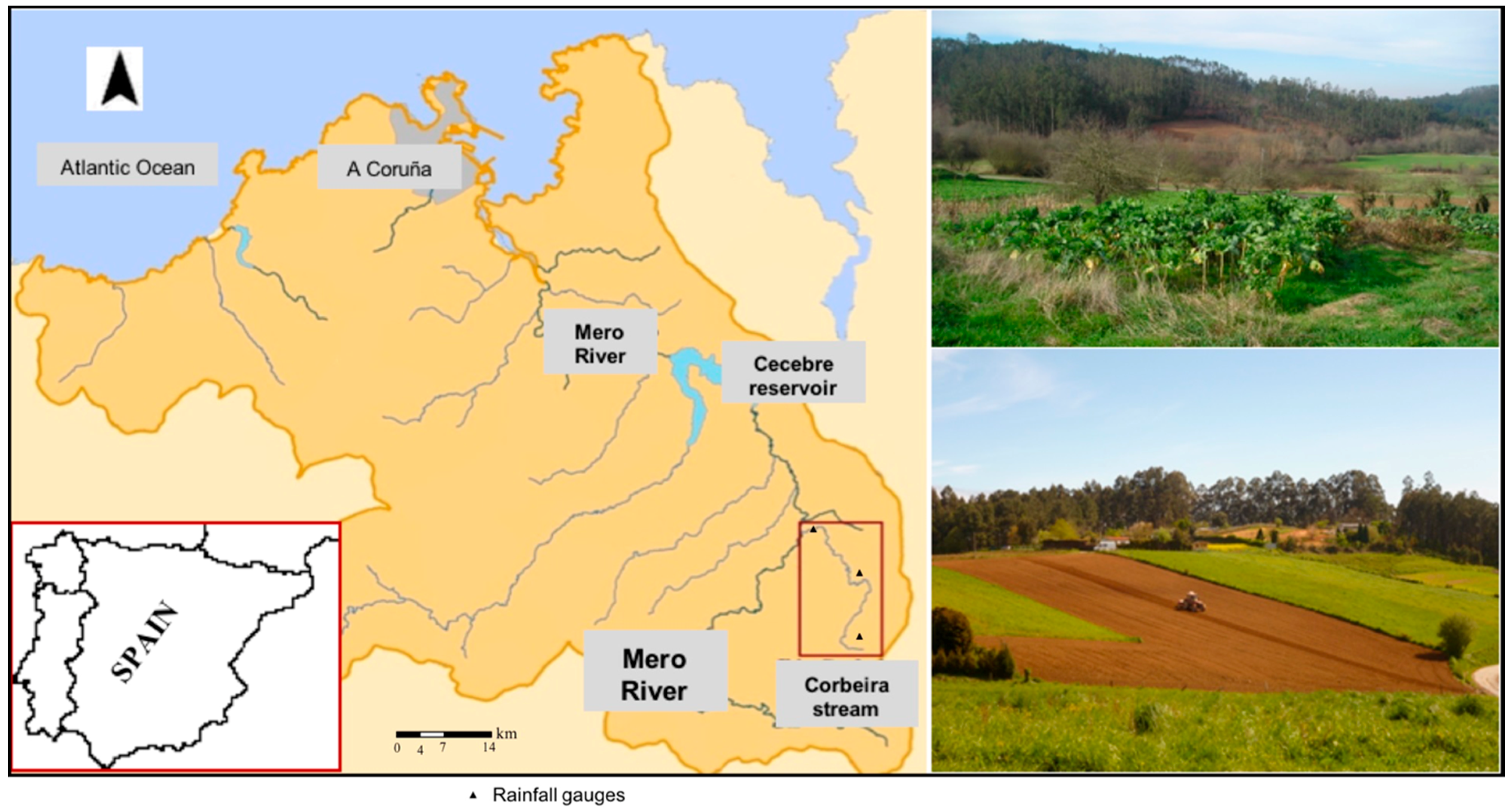

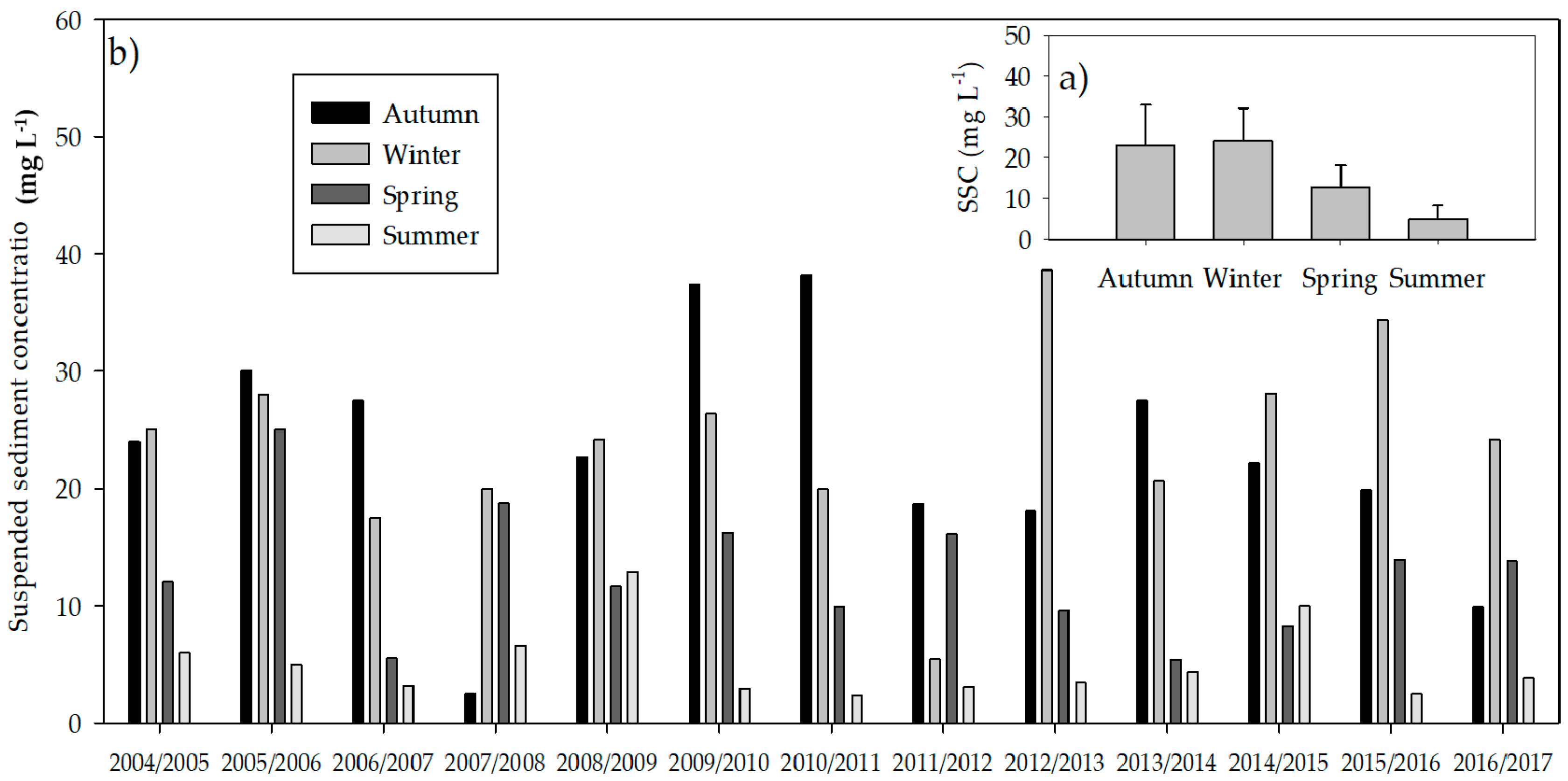



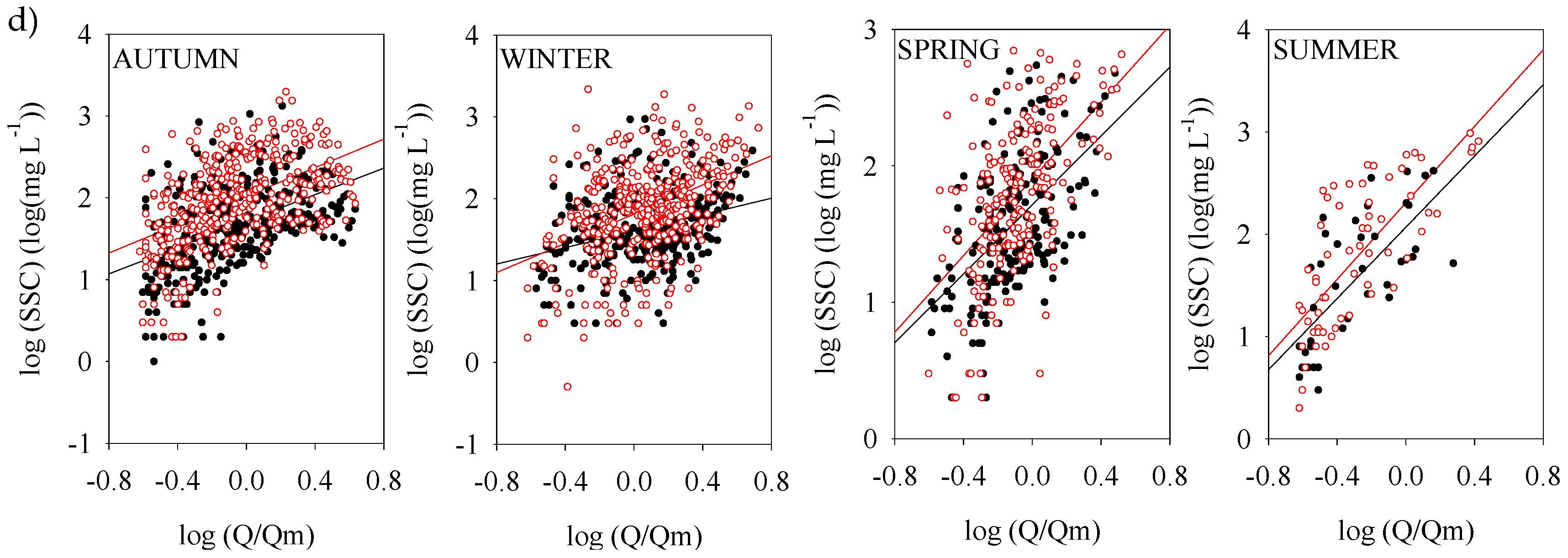
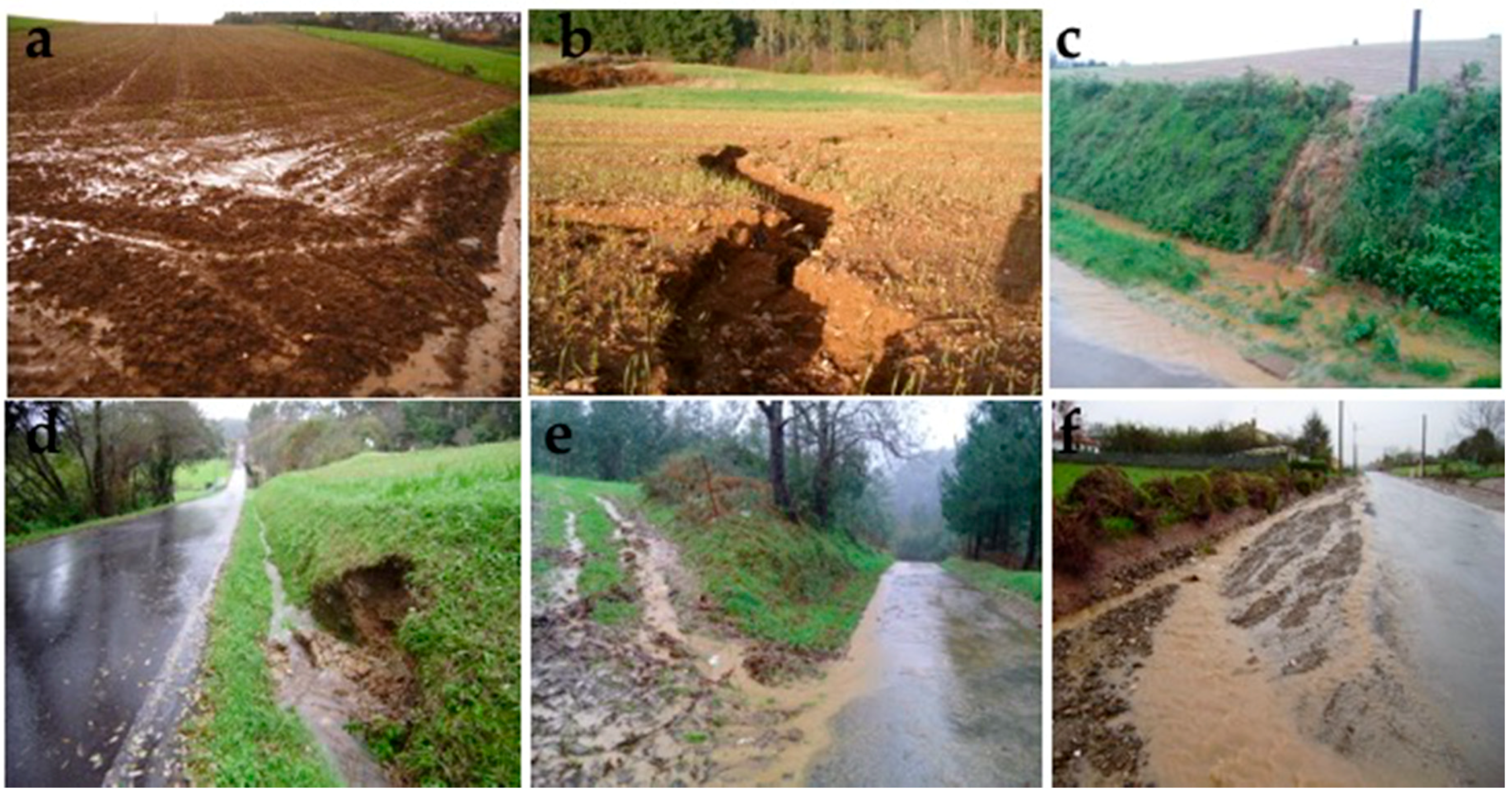
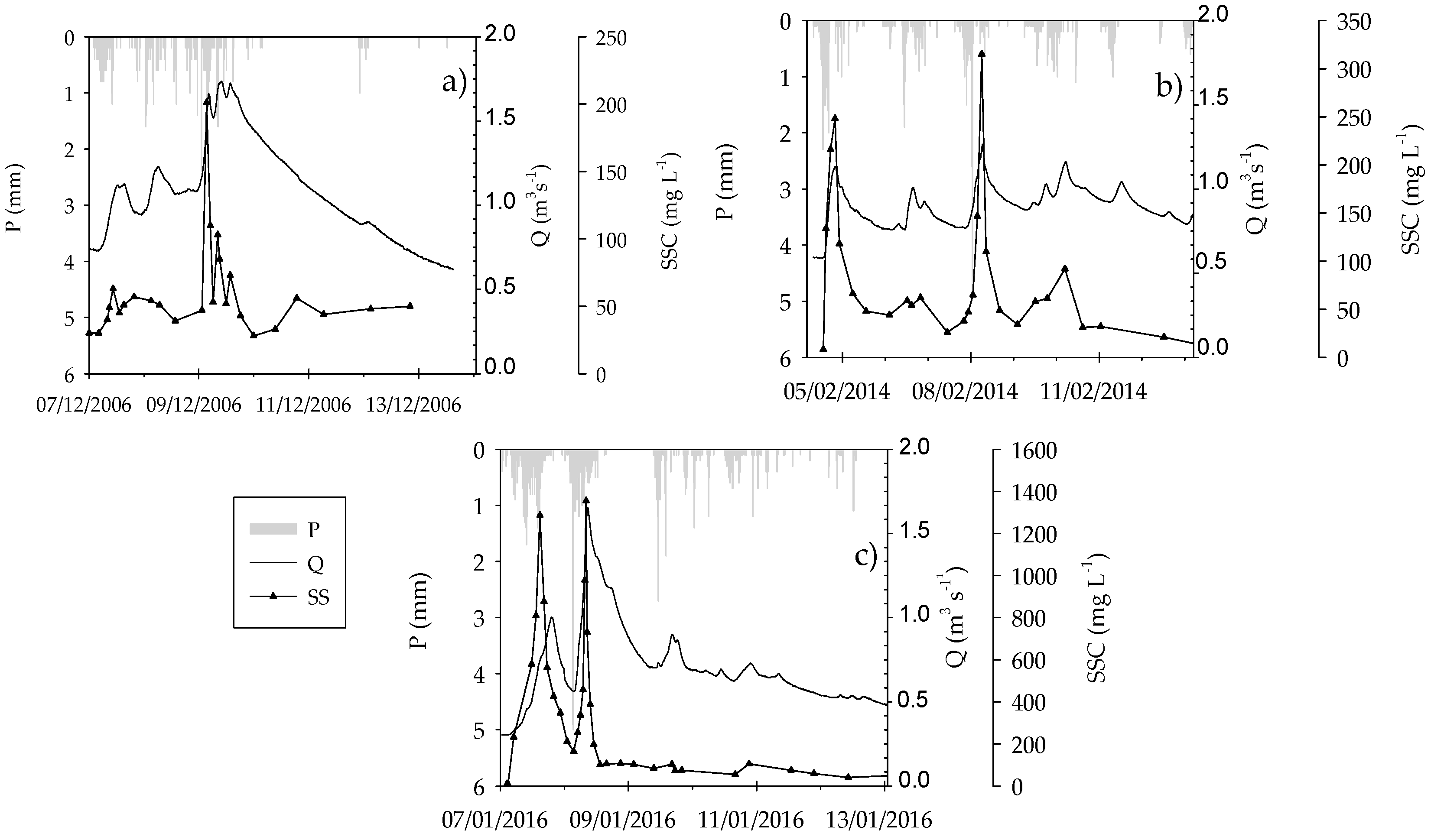
| Hydrological Year | Rainfall (mm) | Streamflow (mm) | RC (%) | Daily Mean SSC (mg L−1) | Max SSC (mg L−1) | >25 mg L−1 (% ST) | SSY (Mg ha−1 y−1) |
|---|---|---|---|---|---|---|---|
| 2004/2005 | 895 | 298 | 33 | 12 | 530 | 7 | 0.04 |
| 2005/2006 | 1192 | 449 | 38 | 19 | 626 | 12 | 0.09 |
| 2006/2007 | 1397 | 412 | 29 | 13 | 850 | 11 | 0.11 |
| 2007/2008 | 1054 | 240 | 23 | 12 | 1313 | 7 | 0.05 |
| 2008/2009 | 1196 | 421 | 35 | 18 | 970 | 15 | 0.12 |
| 2009/2010 | 1382 | 544 | 39 | 21 | 684 | 15 | 0.19 |
| 2010/2011 | 1078 | 373 | 35 | 18 | 1026 | 15 | 0.12 |
| 2011/2012 | 809 | 225 | 28 | 11 | 558 | 5 | 0.04 |
| 2012/2013 | 1207 | 448 | 37 | 17 | 903 | 16 | 0.16 |
| 2013/2014 | 1255 | 434 | 35 | 14 | 895 | 10 | 0.11 |
| 2014/2015 | 979 | 307 | 31 | 17 | 2168 | 11 | 0.10 |
| 2015/2016 | 1483 | 431 | 29 | 17 | 1975 | 11 | 0.16 |
| 2016/2017 | 912 | 140 | 15 | 13 | 1886 | 7 | 0.05 |
| Mean ± S.D. | 1141 ± 209 | 363 ± 113 | 31 ± 7 | 16 ± 3 | - | 11 ± 4 | 0.10 ± 0.05 |
| Regression Equation | Percentage of Variance Explained | p-Value | |
|---|---|---|---|
| Annual | |||
| a parameter | a = 3.74 − 0.01P − 1.27FB | 79% | 0.001 |
| b parameter (slope) | b = 2.89 − 0.02P + 0.02SSCmax | 83% | <0.001 |
| Seasonal | |||
| Autumn | |||
| a parameter | a = 3.38 − 0.008P | 84% | <0.001 |
| b parameter (slope) | b = 4.41 − 0.015P | 70% | 0.001 |
| Winter | |||
| a parameter | a = 3.44 − 1.4 × 10−6R − 2.10KE | 87% | <0.001 |
| b parameter (slope) | b = 5.79−3.2 × 10−6R − 0.72KE | 74% | 0.02 |
| Spring | |||
| a parameter | a = 2.9 − 1.7 × 10−6R | 52% | 0.007 |
© 2018 by the authors. Licensee MDPI, Basel, Switzerland. This article is an open access article distributed under the terms and conditions of the Creative Commons Attribution (CC BY) license (http://creativecommons.org/licenses/by/4.0/).
Share and Cite
Rodríguez-Blanco, M.L.; Taboada-Castro, M.M.; Taboada-Castro, M.T. Long-Term Suspended Sediment Concentrations and Loads from a Relatively Undisturbed Agroforested Catchment in the Northwest of the Iberian Peninsula. Water 2018, 10, 1302. https://doi.org/10.3390/w10101302
Rodríguez-Blanco ML, Taboada-Castro MM, Taboada-Castro MT. Long-Term Suspended Sediment Concentrations and Loads from a Relatively Undisturbed Agroforested Catchment in the Northwest of the Iberian Peninsula. Water. 2018; 10(10):1302. https://doi.org/10.3390/w10101302
Chicago/Turabian StyleRodríguez-Blanco, M. Luz, M. Mercedes Taboada-Castro, and M. Teresa Taboada-Castro. 2018. "Long-Term Suspended Sediment Concentrations and Loads from a Relatively Undisturbed Agroforested Catchment in the Northwest of the Iberian Peninsula" Water 10, no. 10: 1302. https://doi.org/10.3390/w10101302




